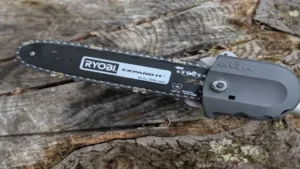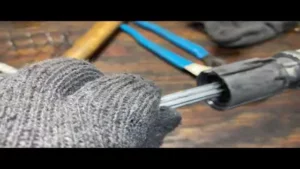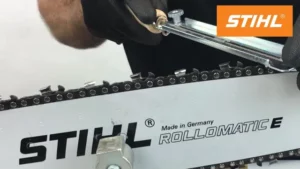Do you have an overgrown tree in your garden that needs some trimming? Are you looking for a way to cut down tree limbs without having to climb a ladder or hire a professional? Well, you’re in luck! Using a pole saw is a safe and effective way to get the job done. A pole saw is a long-handled saw that can reach branches up high without you having to climb a ladder or use a chainsaw. It consists of a blade attached to a long pole, allowing you to reach high and difficult areas that would otherwise be off-limits.
Whether you’re a seasoned gardener or a beginner, a pole saw is a tool that should be in every gardener’s arsenal! But how do you use a pole saw safely and effectively? First and foremost, it’s essential to choose the right pole saw for the job. This will depend on the size of your tree, the diameter of the branches you need to trim, and your own personal level of experience. Once you’ve got the right tools, you’re ready to get to work.
Before you start cutting, it’s important to take safety precautions. Wear the appropriate gear, such as safety glasses, a hard hat, and sturdy footwear. Ensure the area you are working in is clear of any obstacles or debris that could cause a tripping hazard.
And, always make sure that your pole saw is in good working condition before using it. With these things in mind, you’re ready to start trimming away those excess branches! Remember to work systematically and carefully. Start by cutting away any damaged or diseased branches, working your way methodically through the tree.
Keep in mind that proper pruning techniques are crucial to ensure the health and growth of your tree. Using a pole saw to trim down tree limbs may seem overwhelming at first, but with the right equipment and a little practice, it can become a breeze. Not only does it save you time and money, but it’s also a rewarding and satisfying task to take on yourself.
What is a Pole Saw?
If you have trees in your yard, you probably know how important it is to keep them trimmed regularly. However, cutting tree limbs can be a daunting task, especially if they are too high or out of reach, unsafe to climb, or difficult to access. This is where a pole saw comes in handy.
A pole saw is a pruning tool that resembles a chainsaw but with a long pole attached to it, allowing you to trim tree branches that would be otherwise impossible to reach. Pole saws come in different sizes and types, such as gas-powered, electric, cordless, or manual. To use a pole saw, first, assess the height and thickness of the branch you want to cut and choose a saw that is suitable for the job.
Be sure to wear protective gear, such as gloves, goggles, and earplugs, as well as sturdy footwear and clothing. Then, position yourself safely and firmly on the ground and extend the pole saw to the branch. Use a smooth cutting motion and avoid forcing the saw or cutting above your head.
With a little practice, cutting tree limbs with a pole saw becomes a breeze, saving you time and energy while keeping your trees healthy and beautiful.
Definition and Types of Pole Saws
A pole saw is a gardening tool designed for pruning tree branches that are high and hard-to-reach. It consists of a long pole, sometimes telescopic, attached to a saw blade or a chainsaw. This tool allows you to trim branches without a ladder, reducing the risk of injury related to falls.
Pole saws come in two types: manual and powered. The manual ones require physical effort to use, while the powered pole saws are electric or gas-powered and require less effort. Both types of pole saws have their advantages and disadvantages, depending on the task and the user’s preference.
Some models are battery-powered, making them ideal for occasional use. Many professionals prefer gas-powered pole saws for their power and efficiency. In summary, the pole saw is an essential tool for anyone who needs to maintain their trees and shrubs’ growth.

Preparing to Cut with a Pole Saw
If you’re preparing to cut tree limbs with a pole saw, there are a few things you need to do first. Start by determining the height of the branches you want to cut and choose the appropriate length for your pole saw. Make sure your pole saw is properly lubricated and sharpened, so it can easily saw through the thick branches.
Wear protective gear such as safety goggles and a hard hat to protect yourself from falling debris. Assess the environment for potential hazards such as power lines or weak branches that could break or fall during the cutting process. Position yourself firmly on the ground and make sure you have a good grip on the pole saw before you start cutting.
Remember to take your time and focus on the area you want to cut to minimize any damage to the surrounding tree or vegetation. With these simple steps, you’ll be ready to safely and effectively cut through tree limbs with your pole saw.
Safety Equipment and Gear
When getting ready to use a pole saw, it is important to make sure you have the proper safety equipment and gear. This includes gloves, eye protection, and a hard hat. Gloves will protect your hands from debris and the saw blade, while eye protection will prevent wood chips and other debris from getting in your eyes.
A hard hat is also important to wear in case a branch falls from the tree unexpectedly. It is also a good idea to wear long pants and sturdy boots with good traction. Remember, safety should always come first when using a pole saw!
Inspecting the Saw and the Tree Limb
Before using a pole saw to cut a tree limb, it is important to inspect both the saw and the limb. Begin by checking the sharpness of the saw blade. Dull blades can cause tearing, which can harm the tree and make the job much more difficult.
Next, examine the tree limb to ensure it is safe to cut. Broken or damaged limbs should be trimmed back to a healthy section before cutting. It’s also important to check for any obstacles that may interfere with the cutting process, such as nearby power lines or other tree branches.
Finally, consider the location of the cut and make sure it is in an area that won’t harm the tree’s growth or stability. By taking the time to inspect both the saw and the tree limb, you can avoid accidents and create a clean and safe cut for both the tree and yourself.
Techniques on Cutting Tree Limbs with a Pole Saw
Cutting tree limbs with a pole saw can be a challenging task but with the right technique, it can be an easy and safe job. First, identify the limbs you will be cutting and ensure you have enough space to work safely. Next, adjust the height of the pole saw to your desired level and make sure it is secure.
When using the pole saw, angle the blade at a 45-degree angle towards the direction you want the limb to fall. This will ensure a smooth cut and prevent the blade from getting stuck in the tree. Start cutting with short strokes and be patient, ensuring you do not rush the job.
Once the limb is cut, you can use a rope to lower it to the ground safely. Remember to wear protective gear such as gloves, goggles and a hard hat to prevent injuries. With these techniques, you can safely and efficiently cut tree limbs using a pole saw.
Proper Positioning and Angle
When it comes to using a pole saw to cut tree limbs, proper positioning and angle are key techniques to keep in mind. First and foremost, make sure you’re standing on solid ground and that your ladder is secure. You’ll also want to position yourself so that you have a clear view of the limb you’re cutting, while also ensuring that you’re not in harm’s way if the limb were to fall in your direction.
When it comes time to make the cut, consider the angle at which you’ll be cutting. Ideally, you want to make a clean cut at a 90-degree angle to the limb, as this will allow the tree to heal more quickly and prevent any damage to the remaining branch. Remember to take your time and work slowly and deliberately to ensure that you make a clean and safe cut every time.
With a little practice and care, you’ll be able to make short work of those pesky tree limbs and keep your property looking its best.
Cutting Techniques for Different Heights and Sizes of Tree Limbs
Cutting Techniques for Different Heights and Sizes of Tree Limbs, Pole Saw If you want to keep your trees healthy and looking their best, it’s important to regularly cut and trim them. However, not every tree limb is easy to reach. When it comes to cutting high-up or thick branches, a pole saw is a must-have tool.
This handy device consists of a long pole with a saw blade attached to the end, allowing you to reach branches that would be difficult to reach with a regular saw. But using a pole saw isn’t as simple as just extending the pole and going at it. To get the best results, you need to use different techniques based on the height and size of the branch you’re cutting.
For example, if you’re cutting a branch that’s close to the ground, you can use a shallow angle to make the cut. On the other hand, for branches that are higher up, you’ll want to cut from above to prevent the branch from falling and causing damage. By understanding the best techniques for cutting tree limbs with a pole saw, you’ll be able to keep your trees looking their best.
Maintenance of Pole Saws
If you want your pole saw to last longer and work effectively, you need to take care of it. Regular maintenance is crucial for prolonging the lifespan and efficiency of your pole saw. Firstly, always lubricate the blade and chain properly before using it.
This helps to reduce friction and prevent rust. Secondly, always clean the blade after every use to get rid of any sawdust or debris. You can use a soft brush or cloth to wipe off any dirt from the blade.
Thirdly, check the tension of the chain and adjust it accordingly. An overly tight chain can damage the saw and make it difficult to cut while an overly loose chain can come off while using it. Lastly, regularly inspect the blades for any damage or wear and replace immediately if necessary.
With these simple maintenance practices, you can keep your pole saw in pristine condition and effectively cut tree limbs without any hitches.
Cleaning and Sharpening the Saw
Maintaining your pole saw is vital to ensure it operates smoothly and efficiently. Cleaning and sharpening the saw blade regularly will not only keep it looking new but also extend its lifespan. After each use, it’s important to wipe off any debris, sap, or resin on the blade using a clean cloth or soft brush.
You can also use a mild detergent solution to clean it thoroughly. Once clean, make sure to dry it properly before storing. Sharpening the saw blade is also critical to maintain its effectiveness.
You can either use a sharpening file or take it to a professional sharpening service provider. Failure to sharpen the blade can result in reduced cutting performance and can cause damage to the saw’s motor. Proper maintenance not only keeps your pole saw in good condition but also ensures your safety during use.
So, don’t overlook the importance of maintaining your pole saw, as it can make all the difference in the world.
Storing the Saw Safely
When it comes to maintaining your pole saw, storing it correctly is crucial to ensuring its longevity and performance. The first step is to make sure the saw is completely clean and dry before storing it. Any debris or moisture left on the saw can lead to rust and erosion.
It’s also essential to keep the saw in a dry, cool place, away from direct sunlight or heat, and out of reach of children and pets. To prevent any accidents or damage, store the saw with the saw blade guard on, or cover the blade with a piece of cardboard or a protective sheath. Additionally, it’s essential to keep the saw in an upright position to avoid any bending or warping of the blade.
By taking these steps, you ensure that your pole saw remains in excellent condition, ready for the next time you need to tackle pruning tasks around your garden or yard.
Conclusion
In conclusion, cutting tree limbs with a pole saw can be a breeze with the right technique and equipment. Remember to carefully select your cutting location, utilize a sturdy ladder, and position your saw at the optimal angle for maximum precision. And if all else fails, just remember the age-old adage: when in doubt, hire a professional.
After all, there’s no shame in admitting when you’re out of your depth…
or when you just really don’t feel like using a pole saw. Happy cutting!”
FAQs
What is a pole saw used for?
A pole saw is a tool used for pruning and cutting tree limbs that are out of reach.
How long should the pole on a pole saw be?
The pole on a pole saw should be long enough to reach the limbs that need cutting, typically between 8-20 feet.
Can a pole saw be used to cut down an entire tree?
No, a pole saw should only be used for pruning and cutting small branches and limbs. Cutting down an entire tree requires specialized equipment and training.
What safety precautions should be taken when using a pole saw?
Always wear protective gear such as gloves, safety glasses, and a hard hat. Make sure the area around the tree is clear and no one is in danger of being hit by falling branches. Follow manufacturer instructions and never use the saw above shoulder height.
What type of blade should be used on a pole saw?
The type of blade used will vary depending on the specific pole saw, but typically a saw blade with between 10-12 teeth per inch is best for cutting tree limbs.
How do you maintain a pole saw?
After each use, clean the blades and check for any damage or dullness. Sharpen the blade as needed and store the saw in a dry location.
Can a pole saw be used for cutting other materials besides tree limbs?
While a pole saw is primarily used for cutting tree limbs, it can also be used for trimming hedges, cutting small shrubs, and other gardening tasks.






